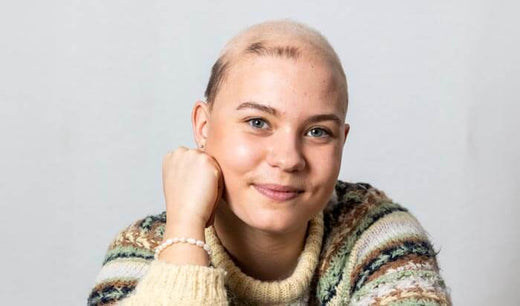What is alopecia areata?
Alopecia Areata is the most widespread variation of Alopecia, and is also called patchy baldness. It's an autoimmune disease, where the body's own immune system goes in and attacks the hair follicles. As a result, all strands of hair in a limited area fall off and the hair follicles go to rest before they start to form new strands of hair again. And it's not just the hair on the head that alopecia can hit. patchy baldness Can also occur in the beard, eyebrows and eyelashes.
Alopecia Areata starts with small bald spots on the head of a few centimeters, and there are often more stain -wise hair loss at once. The bald spots can either move or grow larger. It is very individual how the course is in connection with Alopecia Areata.
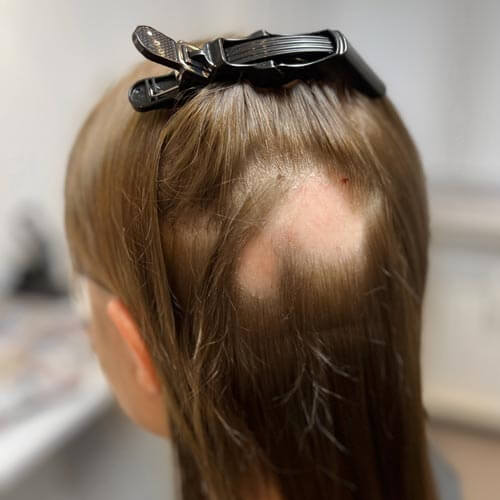
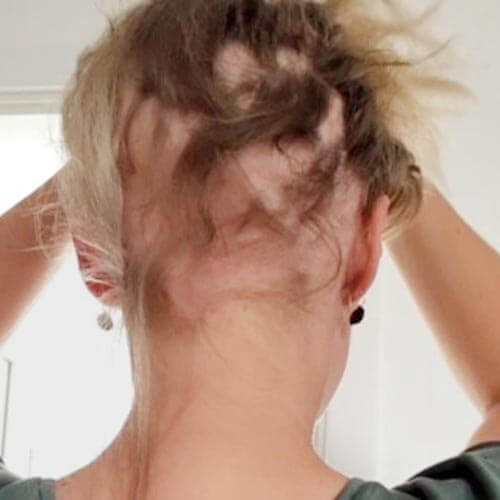
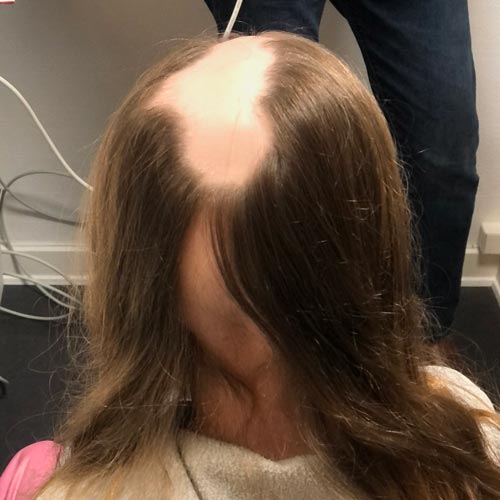
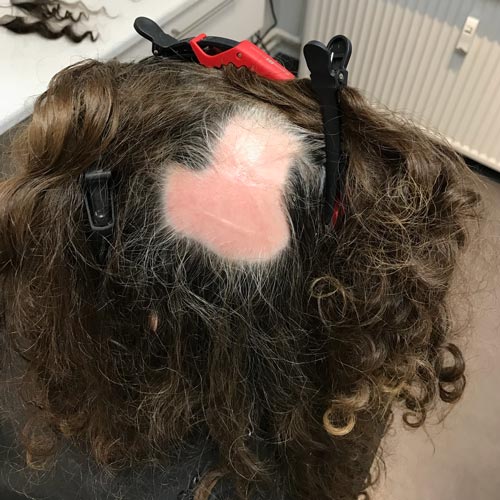
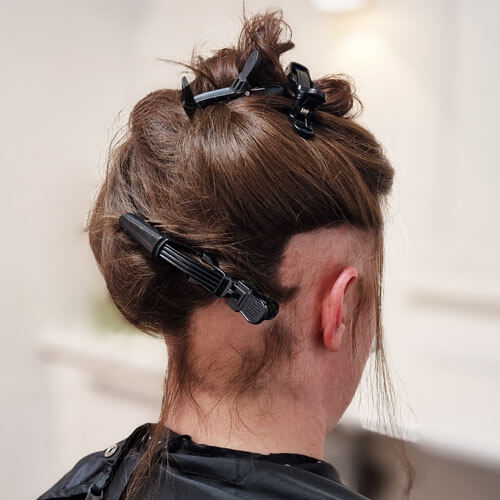
Hvorfor får man pletskaldethed?
Det er endnu uvist, hvorfor pletskaldethed opstår. Men undersøgelser viser, at arvelighed højest sandsynligt spiller en stor rolle. Derudover antydes det, at psykisk stress, infektioner, andre autoimmune sygdomme, såsom diabetes og stofskifteforstyrrelser kan være det, der udløser hårtabet hos arveligt disponerede personer.
Kan man kurere alopecia areata?
Det korte svar er nej. Hvis du lider af pletskaldethed, skal du huske på, at dine hårsække er sat i dvale, og at der er 80% chance for, at du får dit hår igen. Der er endnu ikke udviklet et mirakelmiddel til at få hårsækkene ud af denne dvaletilstand, men der arbejdes hårdt på det. Igennem årene er der blevet eksperimenteret med vitamin- og mineralkure, forskellige slags medicin og specialshampooer, men desværre uden dokumenteret effekt. Derfor er vores bedste råd, at du venter og ser tiden an.
Hårløsninger til pletskaldethed
Hvis dine skaldede pletter er stationære - dvs. at de ikke flytter sig rundt - kan du få en speciallavet hårløsning med Hår for Livet® by Toftild. Her bliver der skåret "hårtotter" ud efter et aftryk af formen på dine pletter. Disse bliver enten tapet eller limet fast, så de bare pletter er skjult.
Hvis pletterne kontinuerligt ændre sig, kan en anden løsning være en hair topper, som clipses ovenpå dit eget hår og dækker bare plamager. Er hårtabet mere omfattende, tilbyder vi selvfølgelig også parykker. Alle hårløsninger fra Toftild ser naturlige ud og blender naturligt ind med dit eget hår.
Nanna har haft alopecia i mange år. Her tager hun jer en tur med i stolen, så i kan se hvordan vi hjælper hende med at skjule sine bare pletter.

Naturlige hårbånd lavet af donationshår
Vi introducerer vores unikke Toftild Hairband, lavet med donationshår, for at give en smuk, naturlig og komfortabel løsning til piger og kvinder, der oplever hårtab. Hårbåndene er særligt designet til dig, der lever med alopecia eller gennemgår kemobehandling, og som ønsker at genfinde følelsen af naturligt hår og personlig stil.

Tilskud til hår
Hvis du har fået stillet diagnosen alopecia hos hudlægen, kan du søge kommunen om en bevilling til hår. En bevilling er et økonomisk tilskud fra det offentlige, som dækker dit køb af paryk eller toupe. Dit tilskud bevilges gennem Servicelovens §112. Du søger om tilskud via borger.dk under kategorien ”hjælpemidler”. Der er altid frit leverandørvalg på dette område, så selvom der står et bestemt leverandørnavn på din bevilling, kan du frit vælge, hvor du køber dit nye hår. Du kan med andre ord altid bruge Toftild, uanset hvilket leverandørnavn, der står på din bevilling. Hos Toftild kan vi også vejlede dig i processen med at søge tilskud til paryk, toupe og andre løsninger til hårtab. Læs mere om tilskudsmuligheder til paryk og toupe her.
Hvordan udvikler alopecia areata sig?
Ifølge sundhed.dk får halvdelen af dem, der rammes af alopecia håret tilbage igen efter 6-12 måneder. Hos andre er tilstanden aktiv i flere år. Her kan håret begynde at vokse ud igen på de ældste bare pletter, hvorimod der opstår nye bare pletter andre steder.
Sundhed.dk oplyser, at ca. 80% af dem, der rammes af pletskaldethed, får deres hår igen. Dog kan det nye hår have en pigmentændring, og i nogle tilfælde er det nye hår hvidt. Det kan være forbigående, men det kan også betyde en permanent ændring i håret i det ramte område.
Har man været ramt af pletskaldethed én gang, og får alt sit hår igen, er der desværre risiko for tilbagefald senere i livet.
Pletskaldethed kan også udvikle sig til alopecia totalis, hvor man mister alt hår på hovedet. Der er også nogle få der rammes af alopecia universalis, hvor man taber alt hår på hele kroppen. Det indbefatter både bryn, vipper, hår på arme og ben, kønsbehåring, ja alt hår på kroppen!
Hvordan stilles diagnosen alopecia areata?
Der er mange ting, der kan forårsage hårtab, såsom stress, vitaminmangel og andre sygdomme. Derfor skal du kontakte din egen læge, som kan undersøge dig. Hvis lægen vurderer, at der kan være tale om pletskaldethed, også kaldet alopecia areata, bliver du henvist til hudlægen, som er den, der stiller diagnosen.
Lider du af pletvist hårtab?
Oplever du selv at tabe håret pletvist eller et generelt hårtab, og ønsker du at høre hvilke muligheder vi har for at give dig mere hår? Så kan du få en gratis og uforpligtende online konsultation hos Lise Toftild, hvor hun vurderer dit hårtab og kommer med vores vurdering af mulige løsninger. Udfyld blot nedenstående formular, og beskriv kort dit hårtab og upload gerne nogle billeder af dit hårtab. Billederne hjælper os med en mere præcis vurdering. Bare rolig, billederne slettes iht. GDPR efter endt evaluering.



